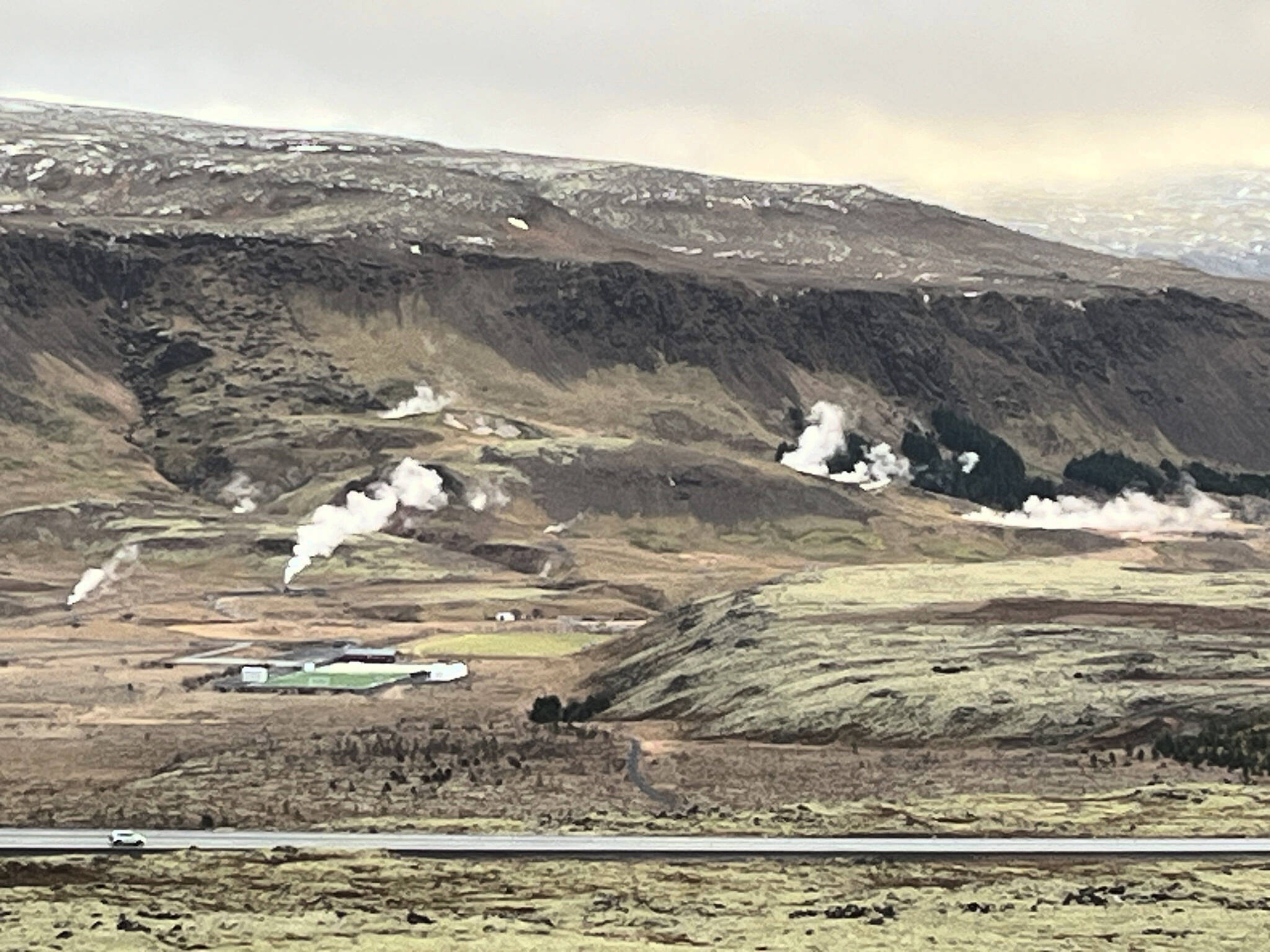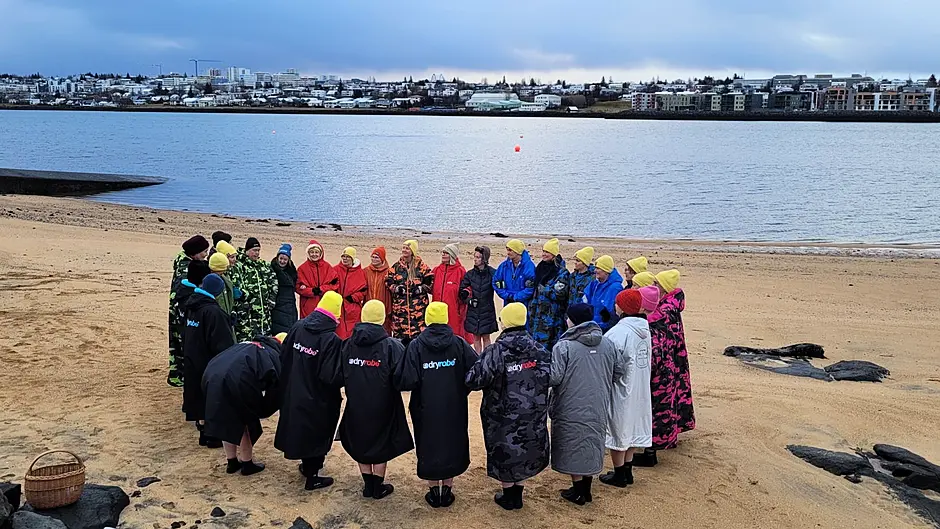Southern Star editor SIOBHÁN CRONIN spent last weekend avoiding cracked roads and anxious news updates about earthquakes and volcanoes as her short break in Iceland turned out to be a little more challenging than she had planned

‘I WAS feeling very anxious last night and I just wanted to share that with you all.’
These words are being spoken by a striking Icelandic woman, wearing a dryrobe over her swimming togs and standing in a circle of similarly dressed women – of which I am one.
We are all linking arms and our neoprene-stockinged feet are on a man-made sandy beach in Reykjavik as the cool north Atlantic waves crash to shore behind us.
Our host is telling us about her anxiety because, as every nationality knows, a problem shared is a problem halved.
The women all nod in recognition of her emotion because every one of us is feeling worried.
The day before the little village of Grindavik, just 54km away, began evacuating its 4,000-plus residents.
The village lies at the foot of the Thorbjorn mountain which contains a volcano that geologists have been getting increasingly worried about.
In the previous three weeks the number of earthquakes – you can track them here – on the Reykjanes peninsula have been shocking in their regularity and, on occasion, strength. Grindavik is nestled close to the southern shore of the peninsula.
Anyone who has travelled to Iceland on holiday will know the area well, because a visit to the world-famous Blue Lagoon spa is essential for any tourist, and the busy lagoon is also close to Thorbjorn.
 The incredibly unusual landscape often features steam rising from the ground.
The incredibly unusual landscape often features steam rising from the ground.
I arrived in Iceland on Thursday of last week – the day the lagoon finally closed to the public, after days of pressure from the government and concerned geologists.
The decision to finally close was probably prompted by a strong earthquake in the vicinity which spooked many tourists staying at the lagoon’s chic hotel.
The Icelanders we spoke to were not too happy with the Blue Lagoon’s casual attitude to what was becoming an increasingly dangerous situation on the peninsula.
As if to prove them right, by Saturday large cracks were appearing in the roads around the lagoon and Grindavik, and by Monday there were massive chasms under the now deserted village.
Many of the women we swam with on Saturday would certainly have had friends or acquaintances in Grindavik and its surrounds, forced to take shelter in neighbouring towns and villages. Iceland is a country of about 400,000 residents in total, and most people are no more than three or four degrees of separation from each other.
This was my sixth trip to our closest northern neighbour and despite the constant threat of nature disrupting travels plans on the island, I can never get enough of these resilient and fascinating Scandanavians and their moon-like landscape.
 Siobhån and her travel companion Helen Coughan from Goleen visiting one of the many spectacular waterfalls in Iceland.
Siobhån and her travel companion Helen Coughan from Goleen visiting one of the many spectacular waterfalls in Iceland.
We had travelled quite close to the active area after landing at Keflavik airport on Thursday, en route to other natural hot springs. Keflavik, the country’s international airport, is also on the same peninsula as our troublesome volcano, so there are constant fears that the country’s main connection with the rest of the world could be interrupted if hot lava were to emerge from Thorbjorn.
But away from the danger zone, we marvelled at the crazy combination of half-frozen lakes, magnificently powerful waterfalls, gurgling hot pools and ribbons of hot steam emanating from randomly-placed holes in the ground.
To say this is a landscape like no other is vastly under-egging it. You have to be there to realise just how dramatic this land – just a two-hour flight from Ireland – really is.
And yes, Iceland is expensive. Many items of food and drink are double the prices here at home, and some more so. We stayed with an Icelandic friend in her incredibly warm and cosy apartment reminding us that the Icelanders are at least thankful that their unusual natural features can provide relatively cheap water and energy to their homes.
As the constant news updates over the weekend heralded an escalating sense of urgency around the Reykjanes peninsula, our superbly cautious host directed us in the opposite direction for our day-tripping escapades.
The further we travelled from the west coast, the more relaxed the locals were.
In the intriguing town of Selfoss we found a brilliant initiative by a group of private interests – they are recreating historic and other noteworthy buildings from around the country that have fallen into disrepair, and making a whole new village-within-a-village.
 The new village centre in Selfoss.
The new village centre in Selfoss.
Each newly-constructed house or shop has a plaque outside with an original photo stating where it originally stood, when it fell into disrepair and when it was rebuilt.
It’s a nine-year plan, to be completed by 2028, but already many of the rebuilt shops and cafés are open, and creating not just a thriving new village centre for Selfoss, but also a unique tourist attraction for the likes of me.
 The nine-year plan for the centre of Selfoss shows the area completed on the left, with about two-thirds of the new village yet to be constructed.
The nine-year plan for the centre of Selfoss shows the area completed on the left, with about two-thirds of the new village yet to be constructed.
One of the buildings which now houses a food hall is a former creamery and in the basement is an exhibition outlining the story of Skyr – the Icelandic low fat and delicious yoghurt that has become an international sensation.
 One of the plaques showing the origins of the building.
One of the plaques showing the origins of the building.
Looking around at the many deserted and dilapidated creameries in West Cork, one can only hope we see the value of these historic gems – like our northern cousins did – before it’s too late to fete them.
Another building has been reworked as a chic café where cool Icelanders were gathering after work on Friday night for cool beers and mouth-watering pastries.
As our departure day of Sunday drew near, we were becoming a little anxious again. Regular texts from our airline reminded us that the flight times could change at any minute, and we were also holding a watching brief on the webcams near Thorbjorn to see if there was any sign of an impending eruption on the way to the airport.
As we drove the 45-minute journey on icy roads from Reykjavik to Keflavik at 5am on Sunday morning, and found ourselves in a lengthy line of cars all heading in the same direction, there was an eerie sense of us abandoning our friends, as we made our exit to safer climes.
It didn’t help that our phones pinged with a message telling us we were in an ‘evacuated’ region and we should ‘please leave the area’.
 A text sent by the Icelandic government warning the public to leave evacuated areas.
A text sent by the Icelandic government warning the public to leave evacuated areas.
As our flight took off, perfectly on time at 7am, I recalled the old adage that what doesn’t kill us makes us stronger.
It might explain why I had found myself, just a day before, walking, hand in hand, and even singing, into an icy 2.5 degree Celsius sea, with a group of determined Icelandic women.
I remembered what our swimming host, in Reykjavik’s Happy Together women’s swimming club had said, after sharing her worries with the group.
 Siobhán joins her new swimming friends as they get ready to step into 2.5 degrees-cool water in Reykjavik
Siobhán joins her new swimming friends as they get ready to step into 2.5 degrees-cool water in Reykjavik
‘I could think of nothing better this morning than to come down here and go for a swim with all of you, my lovely friends.’
And off we headed, singing, laughing, and shivering just a small bit, into the sea off Iceland, happy together.
Siobhán will be discussing sea-swimming with the women of Iceland in a forthcoming episode of her From A to Sea swimming podcast.









